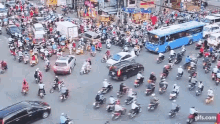“It’s not like the government is forcing you to buy a car!”
If you live in a city with parking minimums, yes they fucking are.
The horrible AI slop looks so bad if you look at it for longer than a second. Do better yall.
Thing is: you don’t need to look at it longer than a second to understand what is meant to be conveyed. So no, goal achieved, good use of resources instead of overspending on one useless metric (=making it realistic)
@Wrufieotnak @hobovision stock images would have worked fine. Or google earth.
I doubt the AI is getting the proportions right. And none of these look like actual places even for one second
Love how confused it gets with drawing parking spots
No point in that big store if I never go to it because I don’t have anywhere to park.
And I love how cute it is that you think there are “car lobbyists”.
If they only lobbied, lol
https://en.m.wikipedia.org/wiki/General_Motors_streetcar_conspiracy
There’s a lobby for a lot of shit and you didn’t take 2 seconds to think about your claim that a major American industry (one that relies on fossil fuel at that) wouldn’t have lobbyists? Like not downvoting you or anything, I’m too embarrassed for you. Hope you’re not someone who takes downvotes etc to heart.
And I love how cute it is that you think there are “car lobbyists”.
https://www.opensecrets.org/federal-lobbying/industries/summary?cycle=2021&id=M02
And why do you think you should need to drive?
There’s a shitload of big stores like that in my city that I can get to in less than 20 minutes without a car.
Your city is frankly built shit if that’s not also the case.
Big box stores, not just big stores. From the from door to one to the front door to the next is just barely reasonable walking distance - and that is assuming you take unsafe shortcuts, go around the parking lot on the sidewalks and it isn’t a reasonable walk (if there is snow they pile that between the two doors). If you want to go to some third store instead of the second you can’t get there in a reasonable walk.
there are many different ways to do a big store. Big box stores are not necessarily any bigger than the others, but the layout of the doors is such that anything other than driving is discouraged by the design and if you do anyway you realize it isn’t safe. There are other big stores where walking is reasonable.
What distance would you call a reasonable walk?
from their front door to their car ofcourse.
And I love how cute it is that you think GM, Ford, Tesla, etc aren’t lobbying for parking minimums.
Also, auto companies have never tried to manipulate a country’s government, no they would never.
Actually curious, is this an ongoing thing in America also, or are you just saying it’d be silly to think it’s not? I’d not considered your perspective before and am unsure if this is a documented issue contributing to American city planning, or if your just saying people should be open to the idea of it
Read all about it here (skip to section 1.5 if you like but the whole thing is worth your time) and then check out Not Just Bikes on youtube, his Strong Towns playlist is a great place to start.
excuse me corporations have no financial incentive ever to behave the slightest fart unethically so they never ever ever will.

So move out of the city 🤷
Public transport is famously existent in the countryside.
Move to the country if you want to drive everywhere then. Leave cities for people who actually value the density they’re supposed to provide.
Is this sarcasm, or satire, or a stroke?
It’s someone who doesn’t know what sub they’re in; this sub is for those living in NYC, LA, SF, and Chicago only. I’m guessing they live in the tiny sliver of the United States that isn’t one of those four cities, hence their confusion.
No it’s not. It sounds like you guys are having some sort of inside joke.
One of the funniest things about American car culture is that Americans probably walk the same distance from their parking spot to the store as I walk from my home.
And they’re walking in car infrastructure. Some of the most unpleasant, not made for humans places, not to mention dangerous. Compared to walking in what a city should feel like.
You’re not wrong in the long term. But in the short term, people will park anywhere possible close to the shop, blocking everywhere near with cars.
@Username @HiddenLayer555 no, the store will just have local customers. And yes there are plenty of those when you can replace the carpark with apartments.
complete bullshit, but even IF drivers were so fucking brain dead, irresponsible, and incapable of being civil, the solution is not to cede to their entirely unreasonable demand that they be allowed to go to some of the most densest places on earth with a fucking couch 2 arm chairs, big chest for all their loot and a whole ass climate control system, if they cant behave they simply shouldn’t have licenses.
Parking tickets
AI slop graphic.
Actually you’re right. Didn’t see that at first.
It still conveys the point pretty effectively regardless
Yeah, I didn’t notice right away, but even after I did, I still think it gets the point across pretty clearly.
I’d probably want it to be human-drawn if it was going to be, for instance, posted up physically outside somewhere, but for something some random person on the internet can do to get a point across, I’d say it’s pretty valid for what it is.
I wonder how accurate it is though.
In this thread: A lot of misconceptions and more than a few poorly thought out comments.
Also in this thread: Identifying the need to restructure the current standard before car usage can be realistically reduced by large amounts.
Also in this thread: Identifying the need to restructure the current standard before car usage can be realistically reduced by large amounts.
The best way to reduce car use is to create an environment where driving isn’t the default (or only) way to get around. Induced demand works in reverse too.
I adore how they use mopeds and scooters in Asia
Yeah I love the smell and sound of a million mopeds. Taiwan is known for its urban serenity.
mopeds aren’t the problem, the problem is that they don’t have enough public transport to handle the sheer absurd amount of people wanting to get places.
imagine how these countries would look if everyone drove a car instead of a moped, society would literally fail because no one would be able to get anywhere
As you point out, they’re not the solution either.
And what about the smell and sound of cars?
Not as bad from my perception. Though I’m not arguing in favour of cars. I just think mopeds are a strange mobility option to adore. Good public transportation + cycling infrastructure is much more adorable. In the Netherlands, the mopeds are a menace to the safety, quiet, and air quality in cities.
For real, a. E-assist bike seems like it solves most of the same problems a moped does, but much more elegantly.
Yes it’s very safe

All I’m getting from this picture is that the biggest danger to scooter riders is in fact cars.
maybe, but scooter drivers are going to lose unfortunately.
Those lots are horribly inefficient, aisle-less parking would make more sense for businesses of that size
They may be horribly ineffecient but that seems to be the standard design. Plus compared to pretty much any other land use, even the most optimized surface level parking lot is an ineffecient use of land.
Urban fabric is when everything’s a building, meaning you can’t go anywhere unless they’ve got the door open for you.
what the fuck were u even attempting to say
sorry what? I can’t understand what you’re trying to say about the door part
“Dark urban alleyways are the scariest parts of a city”, I say as I dart across twelve lanes of traffic on foot.
Are you proposing a society where we never leave our cars and every business is a drive thru? Even if you drive to a wal mart today, they still have to have the door open for you to shop there.
And our current urban fabric is everything is a road, you can’t go anywhere unless you drive a car. Can’t afford a car? Too young to drive? Have a health condition that prevents you from driving? Want to choose a car free life? Too bad.
If your “urban fabric” can’t support access to the public, it doesn’t deserve to survive.
Do you see the people walking in the top left picture?
That’s what access to the public looks like.
ah, so access to the public leaves out people with disabilities.
not much different than today’s reality, but at least you’re open about it.
last i checked mobility scooters exist
More people exist who cannot drive than who have to drive due to disability. Car-centric infrastructure is incredibly ableist.
People with disabilities can’t use sidewalks?
If someone is so disabled that they can’t go out in a wheelchair how are they going out in a car?
last i checked people with disabilities are significantly more likely to walk and use public transport, partly because there are few disabilities that make it so u need a car and many that make it so that u cant drive a car either safely (like random seizures) or at all (like blindness) but also people with disabilities tend to be much poorer and driving is actually expensive as fuck. Public transport and pedestrian infrastructure alongside making streets safer for people by slowing down cars and reducing the overall number of unnecessary cars is actually really good for people with disabilities and even for those few who are forced to drive due to their disabilities surely their lives would be easier if everyone who didnt have to drive were off the roads too.
So if u actually give a shit and that was not just a cheap rhetorical trick then come over to our side and lets destroy car dependency for everyone happiness for the environment and for disabled people.
spoiler
and also for utility vehicle and deliver drivers who are made miserable by being unnecessarily stuck in traffic.
Car centric infrastructure is less accessible though.
Americans have a hard time getting through the culturally ingrained car propaganda.
For some of us American’s we’re trapped in it and it seems like it’ll never go away no matter how much we hate it.
I’m someone who lives in a very rural area because I can’t afford to live in a city… so I need a car. Somehow, a mortgage and sharing a car with my husband is still more affordable than living in a walkable/bikable city in my state. That’s a problem. I don’t know how to fix it, but that’s a freaking problem. Rent in some areas is double my mortgage on my small house. People who rent are getting royally fucked over by ever increasing prices.
If we want people to have less cars then cities need to be affordable for people to live in. It shouldn’t cost more to not have a car. The US has so many backwards problems it starts to feel insurmountable.
Yeah. It takes some real mental gymnastics to think that getting rid of parking minimums, getting rid of a harmful government regulation, increasing freedom, is a bad thing.
@Olgratin_Magmatoe @kurwa I wouldn’t go that far. Just because every step is wrong, doesn’t make the thought process that weird.
I’m saying we should have compassion for their misunderstanding. The conclusion is wrong, but the path to get there isn’t that hard. Particularly when you’ve been raised in that paradigm (or raised watching media that shows it as the ideal).
If your “urban fabric” doesn’t have public transit that’s faster and cheaper than driving, it’s just an overbuilt suburb. America has one city, NYC.
There’s tiny bits of real city around the US. It’s usually leftover fragments that managed to survive through the carpocalypse of the 30’ to today.
There are very few real city places larger than a 1/4 sq mile here.
I wish we could have cities like Chongqing, awesome infrastructure.
It’s not just oppression against “other forms of transport;” it’s literally classist and (to the extent that race corresponds to class, which is a lot and on purpose) racist. A lot of these zoning laws about minimum parking requirements and minimum lot sizes date back to a time when United States government policy was explicitly designed to perpetuate segregation, and forcing every new parcel and development to be large and expensive enough to be unaffordable to most black people (because they were, and still are, poorer on average because of other institutional racism) was a part of that.
lets not forget its also oppression against people with disabilities since they are significantly more likely to use public transport and pedestrian infrastructure.
I was reading about a study that showed how much the climate temperature would rise if every house had solar panels on their roof. I then immediately thought, hey now, what if we had less asphalt everywhere, would that not affect overall temperatures as well?
I live in a country with a propensity for dark cement tiles, i really doubt panels are causing an uptick in heat
I live in a country with a propensity for dark cement tiles, i really doubt panels are causing an uptick in heat
Of course they are why wouldn’t they?
Any change in albedo modifies how much radiation is absorbed and emitted and the wavelengths it’s emitted at.
Sure one tile doesn’t do much but it does do something by a measurable degree. Even if tiny, it’s still quantifiable.
So you’re telling me if I have a house that’s entirely covered in dark cement tiles but put solar panels up my microclimate temperature would rise?
Cities for example have their own microclimate partially because of the change in albedo.
You’re literally talking about something that is well known well documented and well understood and has been for decades.
If you change the albedo of a surface that surface changes it’s absorption of solar radiation. That surface will be warmer or cooler in the Sun. As a fundamental concept (ignoring more exotic materials and concepts). This means that that surface contributes or detracts from the climate in various ways.
I don’t know what’s so difficult about this :/
If you cover the entire country of Australia with black tiles do you really expect that there would be absolutely no change or difference than if you cover the entire country of Australia with white tiles?
Are you actually reading what i am saying?
If anything I’d expect it to be cooler as solar panels also reflect a lot of light
What was the conclusion? Asphalt shingles and slate shingles are already dark, so I’d imagine it would impact covered lighter roofing more.
You have a good point there. The study was done using simulation models, so I should look into what they took into account and maybe who funded the study. You can read it here
Thanks!
Just to be really clear, too, they’re looking at local effects (they say “urban microclimate”), not overall climate.
I work in planning. We removed parking requirements in our downtown districts and a bunch of companies came in to buy the old abandoned buildings and expanded them into the old parking areas.
Every single retail business that moved in over the following 3 years failed because there wasn’t anywhere for the customers to park. They just went to businesses that had parking avaialbe.
Probably would be better off with relatively minor adjustments to overarching standards over time, much akin to parking requirements, but probably that would look more like parking-protected bike lanes downtown, mixed-use zoning, making missing middle housing more available by getting rid of lots of zoning requirements on housing, or, like japan, making them much more comprehensive. None of that costs you anything economically. Parking protected bike lanes just require paint, and you can do that when you need to repave and repaint the main high traffic roads downtown. Eventually you may be able to justify an upgrade to a totally separated bike lane, or you might be able to justify shutting down main street to through traffic and routing things around.
Then you don’t really have to shell out for anything in terms of city transit, you’re just changing some regulations around, and people can walk or bike 2 to 3 minutes to the grocery store on their street corner, from their apartment, which is above a pizza place or whatever the fuck. Bike 3 minutes from the edge of downtown in their rowhome into main downtown where they can pick up groceries. Those people can also have jobs and be economically productive with the higher job density that such a development provides, and this all provides a much healthier and more stable tax base for the city since the utilities cost per person and per business is going to be much less. Course, you’re not gonna get heavy industry like that, but I haven’t really cooked up a solid approach to that sort of commute to a factory or industrial district that doesn’t involve a bus or passenger rail line that just heads straight there, like the USSR did.
The more significant problem with this isn’t so much that it’s some sort of like, totally impossible thing, it’s that any city doing that shit will probably be overrun by a shit ton of annoying gentrifiers, which is a harder problem to solve.
I feel like it’s pretty obvious that the main problem here is with the local NIMBY voters which might not like such a thing, and a significant lack of federal funding. There isn’t really a solid argument against any of the fundamental and somewhat universal planning principles which increase density, walkability, public accessibility, economic efficiency and productivity.
Dude, that’s not gonna happen. As you said, it’s the voters who are the “problem.” Our City Council straight-up banned rezoning any districts to multifamily or 2-family. We have a mixed-use district in the code because we’re required to, but it must be on a plot of land of at least 50 acres along a state highway. The largest single tract of land in the city is 15 acres, and it’s not on a state highway.
We also have a minimum lot size of 1 acre and minimum street frontage for a single-family lot of 150 feet for all newly-platted lots. The citizens super duper don’t want the poor moving in.
But you also have to look at it from a different perspective. Many of these suburban towns are made up of people who actively chose to live a less-urban lifestyle, and as the sprawl approaches them they get very, very hostile. They don’t want new people or more affordable housing. They bought their houses 15 years ago when they cost 80 grand. Now people are buying those same houses for a million dollars and tearing them down to build a 7-million dollar house.
Well you failed your job then, after removing minimum parking requirements you need to add in public transport, make streets walkable and cyclable, you need to induce the kind of traffic that helps build foot traffic, that way the businesses grow naturally around foot traffic.
You got a spare billion dollars for a city with an annual budget of 50 million?
Edit: And my job is to implement the vision of elected leaders as defined in the Comprehensive Plan. We handle the details, but direction is provided by Council.
Seriously, its like you’ve never played Sim City or Cities Skylines. If you are going to rezone or redesign districts and remove parking then you need to, like everyone else is saying, maximize public transit and walkability. Without doing that you are just creating an urban desert.
You gonna pay for it? Our city’s entire annual budget wouldn’t even begin to pay for that.
That’s where parking requirements come from.
If you already have existing transit it likely wouldn’t cost an exreme amount to add a couple stops. If your city doesn’t have any transit then someone should plan some.
Once again, who is gonna pay?
The city can’t afford it without a bond, and voters will never approve an increase in taxes to remove parking and install transit that will increase local (e.g. Voter) commute times and invite the “undesirable elements” from the city they fled to the suburbs to avoid.
We can’t legally force developers to build public infrastructure that isn’t directly required due to their individual business (e.g. traffic signal or wastewater line extension).
Know what we can do? Force developers to build parking for their business through zoning ordinances with minimum parking requirements based on use. So a restaurant needs more parking spaces per square foot than an office building, which needs more than a warehouse.
Most cities cannot afford their extisting road infrastructure maintaince. Once built transit systems and walkability are far cheaper to maintain.
Great.
Your still haven’t offered a solution for how to pay for it.
Our roads are 30 years behind on maintenance, but we can patch them here and there and do one out two major projects a year. And when a street collapses it’s relatively easy to get a bond to fix it because the citizens want their roads back.
We can’t patchwork a public transit system, and the citizens are overwhelmingly against it anyway. We tried buying a single bus to shuttle people around and we had a new city manager following that backlash.
Planners aren’t kings. We’re public servants subject to the will of Council, which is made up of people who represent voters, who overwhelmingly don’t want more density, new people, etc. We have pretty much zero input on the direction of the city.
Shit… we spend way more time reviewing swimming pools for code compliance than actually developing plans. When it does come time to do a new comp plan or transportation study, almost every city outsources that to a third party company.
We pay for it by redeveloping massive multi lane roads into multi transit corridors when their major repair/resurfacing work is due. A few places have used this strategy to redevelop car centric areas into areas with better transit and pedestrian accesses.
The actual day to day job of a planner is closer to Papers Please. 80% of my time is spent reviewing meeting with, reviewing plans of, or writing stag reports about private developments.
In fact, we’re so busy dealing with fights over fence height, pool lighting, and screening of HVAC equipment that most cities outsource their Comp Plan development to third party companies that specialize in it.
If your city is only designed for drivers, it’s no surprise that people will want to drive places. When you remove parking minimums, you also need to prioritize transit and micromobility accessibility, so people are actually incentivized to switch modes. Cities can and are making this shift successfully: here’s one example.
Yes. Let’s spend multiple times our annual city budget to force people to walk in 100-degree heat 4 months out of the year to visit a local restaurant or wait 20 minutes for a shuttle.
They definitely won’t choose to go to the next town over where they can park 50 feet from the door of their destination, and our entire staff definitely won’t be let go in the blowback.
@chiliedogg @PhoenixAlpha did a car write this?
Depending less on car infrastructure will save more tax money long term. Eliminating parking ninimums and building denser developments often increases city tax revenue, turns out parking lots don’t generate a lot of taxable revenue, meanwhile more business space does.
Not empty businesses.
And local governments can only develop with the money they have on hand without a bond, and good luck passing a bond that removes parking, increases taxes, and, in the eye of the voters, invites “undesirables.”
Turns out our money is currently being used for things like keeping water flowing, toilets flushing, libraries open, and other civil projects.
We can make a developer build parking through Zoning codes. We can’t make them build public infrastructure that isn’t directly required for their project.
If we can make a devloper build parking, we can make them build transit stops. The car is not the only thing we can force developers to accomadate.
You can’t just decide what’s legal and what isn’t.
A public transit stop serves more than just the property in question, making it a public project and not a private development. We can’t make private developers pay for public projects. It’s illegal.
Whereas a private parking lot is specifically for that exact development, so it can be mandated.
Planning isn’t a videogame where the perfect solution is achievable. We have to work within the confines of the existing legislative and legal environment.
The city could at least communicate with the development plans and purchase the required land for public stops. The city could mandate certain developments require this kind of transit inclusion to the planning process. The city can also mandate for denser zoning around major transit corridors.
The college I went to maintained a roundabout for buses. The college had to fully cover the costs of pavement maintaince and snow removal. It seemed worth it since tons of their students were arriving by bus, because it delivered them to the center of campus.
I hate car dependence too but when I see things like this I wonder what your solution is for people like me who can’t really walk much.
What would your solution for a blind peron be in this car dependant world? Having multiple transportation options is the most fair system. Right now in many places the car is the only option.
Would accessibility be a solution here? I am speaking about public transport that has dedicated spaces for wheelchairs, has ramps to get on and off etc., as well as sidewalks that are accesibil by wheelchairs, with a smith surface and ramps to get on and off to. Maybe combine that with lifts to access pedestrian subways and overbrides.
Possibly it could also mean the ability to rent, best case for free and at a place reachable by public transport with very little or no walking, a wheelchair or a simiiular solution that let’s one drive rather then walk.
I’m just thinking loud, but maybe such solutions should be considered in every walkable city.
I don’t see any comment asking to remove all cars from the roads. Only that viable alternatives to driving be made possible by sensible zoning instead of building everything solely to cater to cars.
Having big parking lots for people to walk across has the same problem. If you can’t walk far it’s better to have density so you don’t have to walk as far.
Handicap parking spots already solve that problem though
Not everyone who can’t really walk much qualify for handicapped status. The majority don’t. The elderly as just one example.
Additionally, on-street parking gets you even closer to where you want to go. In fact, if more people who can walk did walk, it would make it even easier for people who can’t who won’t have as much competition for good parking spots.
uhh, mobility scooters and wheelchairs? i’m a bit confused as to how this isn’t really easy to answer




















